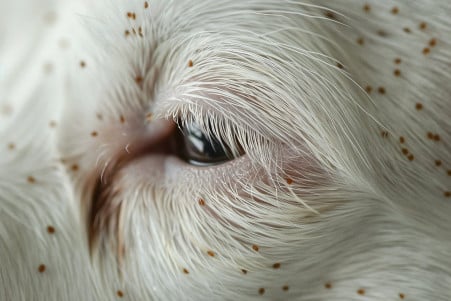How to Know if Your Dog Has Fleas and How to Get Rid of Them: A Comprehensive Guide
6 June 2024 • Updated 5 June 2024

If your dog is itching and scratching more than normal or you see little black specks in their fur, your dog may have fleas. To check, part your dog's fur and look for small, brownish-red bugs moving around on their skin. You may also see flea dirt, which resembles black pepper or coffee grounds. Other symptoms include biting, licking, or scratching at the skin, red skin rashes, hair loss, and pale gums due to blood loss.
Although it can be overwhelming to deal with a flea infestation, we'll cover evidence-based methods to help you identify, get rid of, and prevent future infestations. By learning about the flea life cycle and taking an integrated approach that uses products recommended by veterinarians, you can kick these annoying bugs to the curb and help your dog feel better. Our article is backed by expert advice and the experiences of real dog owners to ensure that you have trustworthy ways to get rid of fleas and their eggs, so you can keep your dog and your home free from these pests.
Does your dog have fleas?
In-Depth Inspection Methods for Finding Fleas
One of the best ways to find out if your dog has fleas is to use a fine-toothed flea comb to check your dog's fur. Make sure to check the base of the tail, the belly, and behind the ears, as these are the most common places for fleas to hide, according to WebMD.
To make sure that you're able to see any fleas or flea dirt that falls off of your dog, Banfield Pet Hospital recommends that you comb your dog over a white surface or towel. Then, part the fur in the opposite direction and look at the skin to see if you can find any adult fleas or flea eggs.
If you see any small, dark specks that you think might be flea dirt, PuppyLeaks says that you can put a drop of water on it to see if it turns reddish-brown. If it does, that means that the speck is flea dirt, which is the feces of a flea and is made up of digested blood.
Make sure to check your dog's bedding, your carpets, and any other areas that your dog spends a lot of time in for signs of fleas, including flea dirt and eggs, according to BondVet. It's important to check both your dog and your dog's environment to make sure that you catch and get rid of any fleas early.
Natural and Home Remedies for Flea Control
The Wildest notes that apple cider vinegar sprays and baths can help repel fleas and interrupt their life cycle, and lemon or lime juice baths can help repel fleas and calm itchy skin. Volhard Dog Nutrition says that cedar, eucalyptus, peppermint, and lavender essential oils have natural insecticidal properties and can be used in collars or sprays, but some are toxic to dogs so they should be used with caution.
Dogs Naturally Magazine recommends diatomaceous earth, a natural powder made from fossilized algae, that can be sprinkled around the house to kill fleas and their larvae. In addition, ElleVet Sciences says that nematode worms can be used to control flea populations in the yard and are safe for pets and the environment.
Although these natural remedies can be helpful, it's important to talk to your vet to make sure they are safe and suitable for your dog's individual situation. A combination of natural and vet-approved treatments may be the best way to make sure that you're effectively treating and preventing flea infestations.
Veterinarian-Recommended Flea Prevention and Treatment Options
When it comes to choosing the right flea prevention for your dog, it's important to talk to a vet, says Dr. Tiffany Ruiz-Dasilva, a professional services veterinarian, who explains that there are a number of things to take into account, including your dog's age, size, and health. There are oral medications, topical treatments, and collars that can help kill adult fleas and prevent future infestations.
Some products, like Simparica Trio, also protect against ticks, heartworm, and other parasites. While flea shampoos and dips can be used to treat active infestations, WebMD warns that they should not be used in place of regular preventative care.
The American Kennel Club notes that a combination of treating the dog and the dog's environment is often needed to control fleas, explaining that this can include vacuuming, washing bedding, and using insecticidal sprays or foggers in the dog's environment.
Environmental Control and Home Remedies
Keeping a clean, well-groomed environment is important in preventing and getting rid of flea infestations. The American Kennel Club says that regular vacuuming of carpets, furniture, and other potential breeding areas can help get rid of flea eggs, larvae, and adult fleas. Washing the dog's bedding and anything else they come into contact with in hot, soapy water can also help kill fleas and their eggs, notes WebMD.
For more specific indoor flea control, Dogs Naturally Magazine recommends using insecticidal sprays, powders, or foggers that are made for indoor use in areas where the dog spends time. To control outdoor flea populations, the magazine says that the yard can be treated with beneficial nematodes, diatomaceous earth, or insecticides.
It's important to stay on top of things and check for signs of fleas regularly to make sure that they don't come back. By making sure to thoroughly clean and treat both your dog's living space and the areas outside that they visit, you can make sure that you get rid of the fleas and keep your home and pet flea-free.
Conclusion: How to Keep Your Dog Free of Fleas
It is important to regularly check your dog for fleas and flea dirt and to address any infestations as soon as possible. Work with your vet to find the best flea prevention and treatment methods for your dog. Use a multi-pronged approach that includes treatment for your dog, cleaning your home, and managing your yard.
You may also want to use natural treatments in addition to those recommended by your vet to take a more holistic approach to flea control. Finally, keep your dog and your home clean and well-maintained and be on the lookout for fleas to prevent future infestations and keep your dog healthy and happy.


